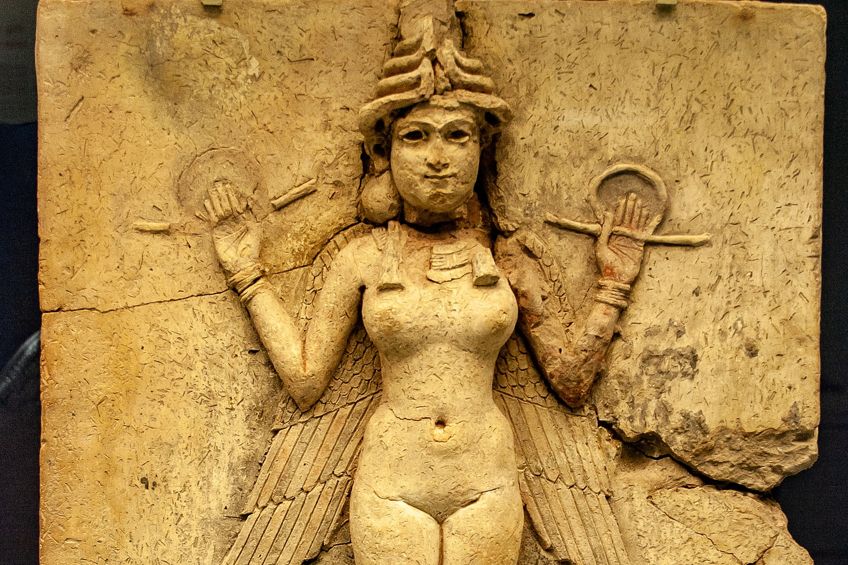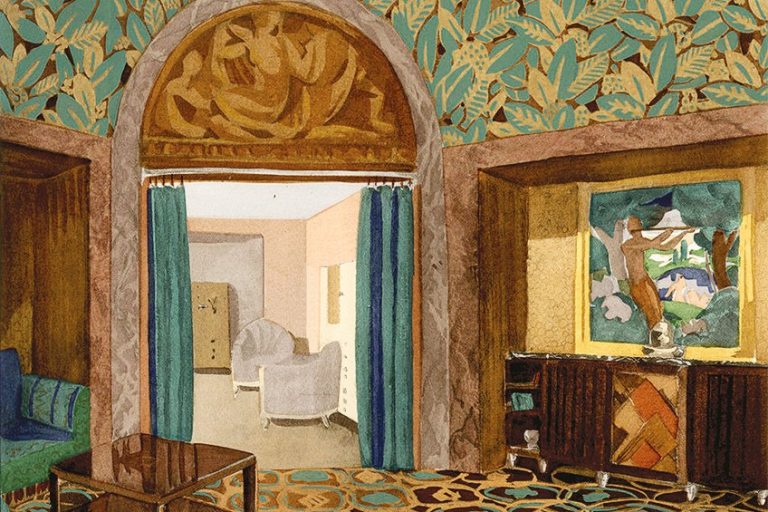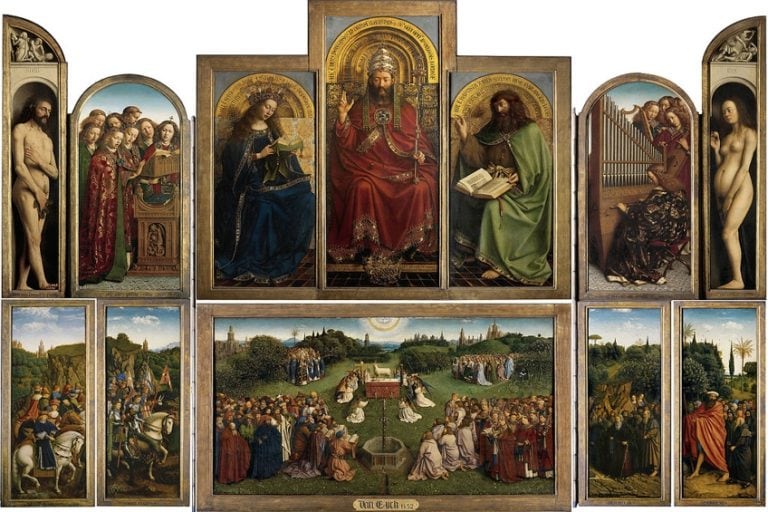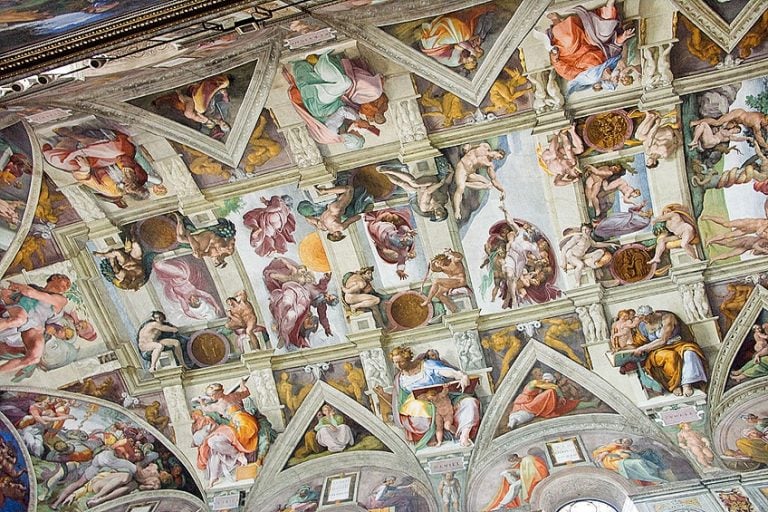Babylonian Art – An Art Exploration of Ancient Babylon
Today, we will look at the history of Babylon artifacts and Babylonian art. Ancient Babylon was a city in Mesopotamia and is ranked among the most powerful cities of the ancient world. Let’s explore the story of Babylon paintings, tablets, and Babylonian statues in this article about Babylonian art!
An Exploration of Babylonian Art
Babylon was a remarkably advanced civilization considering the time period in which it thrived. The Babylonians created significant astronomical record compendiums that included catalogs of star constellations, as well as techniques for calculating different astronomical coordinates and occurrences. In terms of medicine, the Babylonians pioneered basic medical processes like prognosis, as well as cataloging a wide range of ailments and their symptoms. Both sexes in Babylonia learned how to read and write, and the majority of Babylonian literature is based on translations of ancient Sumerian works such as the Epic of Gilgamesh. Babylonian Art was equally impressive for its time, and today we shall explore its history and types.
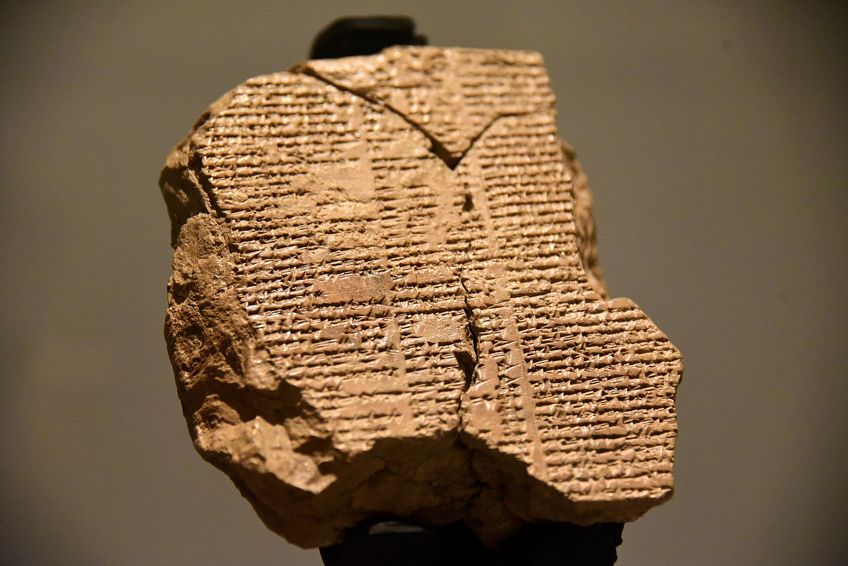 Tablet V of the Epic of Gilgamesh (2003-1595 BC); Osama Shukir Muhammed Amin FRCP(Glasg), CC BY-SA 4.0, via Wikimedia Commons
Tablet V of the Epic of Gilgamesh (2003-1595 BC); Osama Shukir Muhammed Amin FRCP(Glasg), CC BY-SA 4.0, via Wikimedia Commons
History of Babylon Art
Babylonian art was produced by the inhabitants of ancient Babylonia, a society that flourished in Mesopotamia, in present-day Iraq, from roughly the third millennium BCE until the sixth century BCE. Babylonian art is marked by its elaborate patterns, exquisite carvings, and use of vibrant colors. The oldest known specimens of Babylonian art are the clay tablets that would be used to document religious and governmental information. Simple geometric designs and stylized figures were regularly used to embellish these tablets.
The Babylonians also built exquisite structures, such as the iconic Ishtar Gate, which was covered with multicolored glazed bricks.
The gate was devoted to the deity Ishtar and contained reliefs of holy creatures in Babylonian mythology such as bulls, lions, and dragons. Another marvel of Babylonian architecture was King Nebuchadnezzar II’s palace, which featured magnificent sculptures and reliefs. The most notable aspect of Babylonian art is its gigantic Babylonian statues, which were usually fashioned of bronze or stone. Divine beings, monarchs, and other significant characters were portrayed in these sculptures. The Stele of Hammurabi, a stone slab containing a legal code and depicting the monarch receiving the law from the deity Shamash, is one of the most outstanding pieces of Babylonian sculpture.
 Stele of Hammurabi (1793 – 1751 BC); Hammurabi, CC BY 3.0, via Wikimedia Commons
Stele of Hammurabi (1793 – 1751 BC); Hammurabi, CC BY 3.0, via Wikimedia Commons
The top of the stele depicts Hammurabi obtaining the rules from the deity Shamash, while the remainder of the stele carries the laws in cuneiform character. Smaller Babylon artifacts like pottery, jewelry, and cylinder seals were also featured in Babylonian art. Particularly valuable were the cylinder seals, which were used to imprint designs into clay tablets as a type of signature. These were typically fashioned of stone or clay, with elaborate motifs cut onto the surface with a tiny drill. The pictures depicted gods, animals, and images from everyday life, and they were usually beautifully detailed and emotive.
Type of Babylonian Artworks
The majority of Babylonian sculptures were constructed of stone or terracotta and represented characters with huge, stylized eyes and exaggerated features. Little cylindrical items were carved with complex patterns and cylinder seals were utilized to stamp pictures onto clay tablets. The Babylonians were talented metalworkers who created jewelry, swords, and equipment out of silver, gold, and bronze.
Babylonian pottery was primarily constructed of clay and intricately adorned with motifs from ordinary life, such as agriculture or hunting.
Babylon Paintings
The notion of perspective was still somewhat crude, and the figures weren’t as evenly proportioned between them and the surrounding objects compared to real life; this pertains to depictions of both animals and people. The artist typically enlarged the most significant characters; for instance, the King’s figure is the biggest in the group, followed in size by the major individuals that symbolize authority after the King, and last by their followers. Remnants of the Mari Palace’s painted ornaments, which adorned the Royal Patio, the Audience Room, and other rooms in the abode, have been discovered, and they are significant because they depict four kinds of typical scenes in Babylonian culture.
 Fresco of the investiture of Zimri Lim (19th century BC); Louvre Museum, CC BY-SA 2.0 FR, via Wikimedia Commons
Fresco of the investiture of Zimri Lim (19th century BC); Louvre Museum, CC BY-SA 2.0 FR, via Wikimedia Commons
Mythological figures, images of combat, sacrifices, offerings, and inaugurations were all popular subjects in Babylon paintings. Even if the individual is facing front-on, their heads are displayed in profile. Their features are expressionless, like in Sumerian and other Mesopotamian cultures and these figurines usually feature huge defined eyes. The inclusion of long curly hair, beards, embroidery on robes, and fringe on garments demonstrates a good eye for detail, which also provides a fairly accurate picture of what things were like, communicating more effectively than one would expect for this period.
Babylonian Statues and Sculptures
The embossments were nearly always secular in nature. The inside walls depicted images from the palace’s peaceful existence, while the external walls depicted hunting scenes, wars, and heroic stories that lauded the Monarch and epic tales. The ronde-bosse figures, which sometimes had enormous proportions, were mostly found near the palace entrances, acting as guards of the property. These were human-animal hybrids, such as griffins, winged sphinxes, and lions observed in Assyria and Sumer. Numerous Babylonian sculptures were put in temples and other prominent sites because of their religious and symbolic significance.
They offer a fascinating peek into this ancient civilization’s art and culture.
Clay Tablets and Rollers
Roller manufacturing thrived throughout the First Empire. They were employed to stamp printed papers and baked clay tablets. Several manuscripts from the Babylonian civilization have been retrieved using this technique of cuneiform writing. These writings have provided useful information that describes parts of their history, customs, and culture. Several of these manuscripts wound up in the hands of the Assyrians during their invasion of Babylon, who bragged about how many manuscripts in cuneiform writing they had stolen from the Babylonian people.
 Cuneiform cylinder: inscription of Nebuchadnezzar II describing the construction of the outer city wall of Babylon (604–562 B.C.); Metropolitan Museum of Art, CC0, via Wikimedia Commons
Cuneiform cylinder: inscription of Nebuchadnezzar II describing the construction of the outer city wall of Babylon (604–562 B.C.); Metropolitan Museum of Art, CC0, via Wikimedia Commons
More than 17,000 clay tablets with commerce and provincial customs information have been recovered in the cities of Ebla and Mari. We understand from these tablets that their principal export was fabrics and that significant quantities of silver and gold derived from the taxes of the smaller towns under their control were available for use in city maintenance, in addition to being used by the army and to produce military bells. The tablets also demonstrate how they prevented illnesses from spreading and cured them with natural resources. The clay tablets discovered in Babylon also reference persecution games created to identify runaway slaves, as well as fees levied to cross the Euphrates.
These ceramic tablets, which may still be found in the Iraqi region today, have provided details on almost every aspect of Babylonian art and culture, as well as basic information on the Mesopotamian area, covering aspects such as economy, politics, medicine, religion, music, poetry, dance, as well as other aspects of society.
Experts have to labor diligently in a race against the clock to fully interpret, read, and preserve this information. When tablets are removed from their original location, where they have been used to certain physical circumstances, they begin to decay fast. The contents of the tablets are immediately replicated to holographic printouts, allowing the data to be digitized and preserved without requiring the manipulation of the original tablets. This information may also be transmitted to experts all across the world, who will provide useful feedback to give it a multidisciplinary perspective.
Characteristics of Babylonian Art
Babylonian art is considered an essential element of the ancient Mesopotamian civilization’s cultural legacy, and it is characterized by a range of particular features. Figurative representations in Babylonian art comprised portrayals of animals, humans, and mythical entities. These images were highly stylized, with a notable focus on geometric patterns and shapes. Babylonian statues of rulers and deities, for instance, were portrayed with styled beards, complex headpieces, and elaborate patterns on their garments. Animals like bulls, lions, and eagles were depicted in Babylonian art as emblems of strength and authority. These beasts were portrayed with great accuracy and were typically displayed in motion.
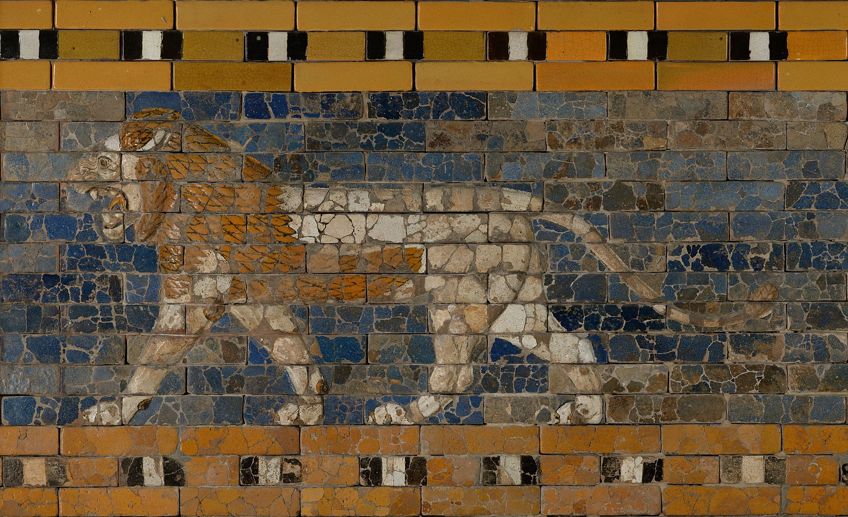 Processional Way, Babylon (604 BCE – 562 BC); Pergamon Museum, Public domain, via Wikimedia Commons
Processional Way, Babylon (604 BCE – 562 BC); Pergamon Museum, Public domain, via Wikimedia Commons
Babylonian art also contained abstract motifs and patterns, such as the elaborate geometric designs that covered many of their structures and ceramics, in addition to figurative portrayals. These designs were often incredibly symmetrical, with an emphasis on repetitive patterns and geometric forms. Narrative themes were used extensively in Babylonian art to share tales and also used for conveying their thoughts and ideals, as well as conveying the strength and authority of their kings and gods. Another prominent medium for Babylonian ornamental art was pottery.
Many such pieces of Babylonian pottery exhibited characteristics of sophisticated geometric patterns and decorations, which were painted employing a process known as “slip painting”.
This entailed adding a thin coating of clay slip to the pottery’s surface and then painting elaborate motifs on top using a delicate brush. Metalwork also served as an important medium for Babylonian ornamental art, as evidenced by several bronze and gold Babylon artifacts with elaborate patterns and decorations. The bronze skull of an Akkadian monarch, which was adorned with elaborate patterns and exaggerated facial characteristics, is a notable example of this type of Babylonian metalwork.
Examples of Babylonian Art
In this last section, we will examine a few notable examples of Babylonian art. This will help illustrate some of the characteristics mentioned above. Let’s start with the Queen of the Night relief.
 The Lion of Babylon Statue at the ancient city of Babylon, Mesopotamia, Iraq (6th Century BC); Osama Shukir Muhammed Amin FRCP(Glasg), CC BY-SA 4.0, via Wikimedia Commons
The Lion of Babylon Statue at the ancient city of Babylon, Mesopotamia, Iraq (6th Century BC); Osama Shukir Muhammed Amin FRCP(Glasg), CC BY-SA 4.0, via Wikimedia Commons
The Queen of the Night (c. 1800 BCE)
| Artist | Babylonian Era Artists (c. 1800 BCE) |
| Date | c. 1800 BCE |
| Medium | Clay |
| Dimensions (cm) | 39 x 37 |
| Location | Room 56, British Museum, London, United Kingdom |
This huge plaque is modeled in high relief and created from baked straw-tempered clay. The curvy nude female’s figure was originally colored red. She bears the horned helmet of a Mesopotamian goddess and bears a rod and the ring of justice, both of which are emblems of her divinity. The deity’s long multicolored wings fall downwards, implying that she is an Underworld deity. Her legs culminate in bird of prey talons, identical to the owls on either side of her. Originally, the backdrop was a dark color, indicating that she was connected with the night. She is accompanied by two lions, and the scale-like pattern represents mountains.
The figure might represent an incarnation of the deity Ishtar, the Mesopotamian goddess of physical intimacy and battle, or Ishtar’s sister and adversary, the deity Ereshkigal, who presided over the Underworld, or even the demon Lilitu, also referred to as Lilith in the Scriptures.
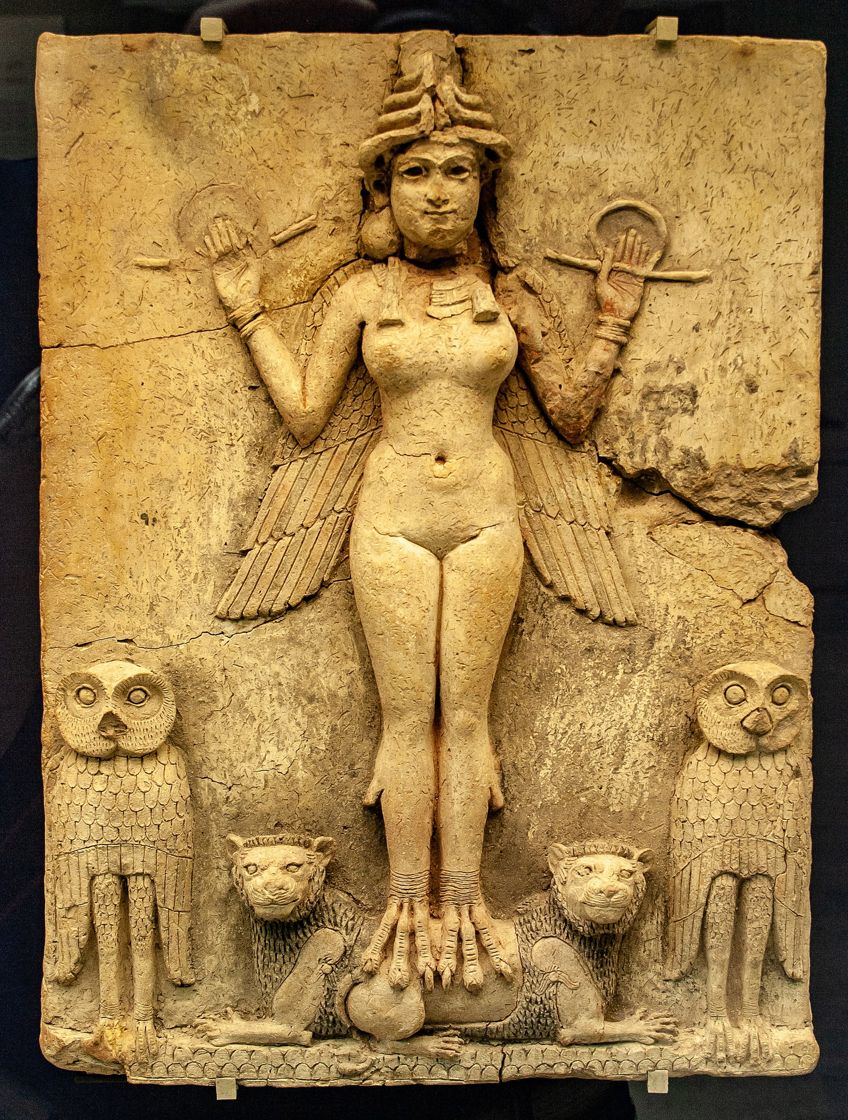 The Queen of the Night (c. 1800 BCE); British Museum, CC BY-SA 4.0, via Wikimedia Commons
The Queen of the Night (c. 1800 BCE); British Museum, CC BY-SA 4.0, via Wikimedia Commons
The plaque was most likely initially housed in a shrine. About 1750 BCE, the same deity appears on tiny, rudimentary, mold-made plaques from Babylonia. The sculpture may have arrived in London as early as 1924 and was taken to the British Museum for scientific investigation in 1933. Since its appearance in the Illustrated London News in 1936, it has come to be known as the Burney Relief, named after its owner at the time, and it was privately owned until 2003. The British Museum’s Director and Trustees chose to make this magnificent terracotta plaque the centerpiece of the museum’s 250th-anniversary celebrations.
Ishtar Gate (575 BCE)
| Artist | Babylonian Era Artists (c. 575 BCE) |
| Date | 575 BCE |
| Medium | Glazed bricks |
| Dimensions (cm) | 1400 x 1500 |
| Location | Hillah, Babil Governorate, Iraq |
The Ishtar Gate was built in 575 BCE by Babylonian King Nebuchadnezzar II. It was the city of Babylon’s eighth gate and the major entry to the city. It was part of Nebuchadnezzar’s attempt to enhance his empire’s capital, and he also renovated the temple of Marduk and erected the famed wonder: the Hanging Gardens as a component of this plan in the early years of the sixth century BCE. It was so magnificent that it was initially included on the Seven Wonders of the Ancient World list.
The gate got its title from the Babylonian deity Ishtar, however, Nebuchadnezzar honors several other Babylonian deities through different animal images depicted on the walls of the gate.
Young lions, and dragons are among the creatures depicted on the gate. These animals are generally connected with certain deities: lions with Ishtar, bulls usually with Adad, and dragons with the god Marduk. Ishtar was a love, fertility, war, and sex goddess, Adad was a weather deity, and Marduk was Babylon’s supreme god. The front of the gate is embellished with glazed bricks depicting dragons and bulls in alternate rows. A legendary monster represented on Ishtar gate had the head of a gazelle, the body of a lion, and the tail of a serpent.
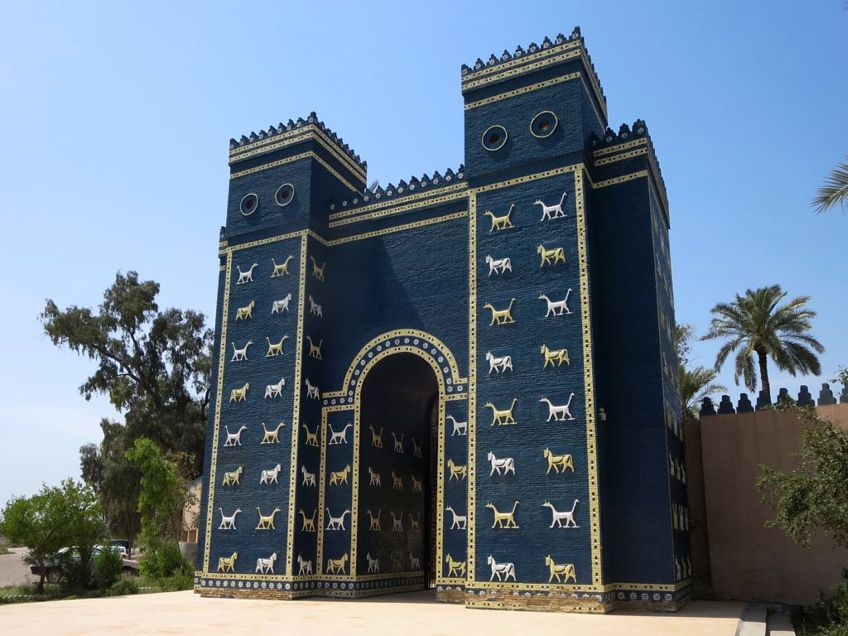 Ishtar Gate (575 BCE); David Stanley, CC BY-SA 3.0, via Wikimedia Commons
Ishtar Gate (575 BCE); David Stanley, CC BY-SA 3.0, via Wikimedia Commons
These motifs stood in stark contrast to the Assyrians’ martial friezes. The animals are adorned in brown and yellow tiles, with blue brickwork around them. The blue enameled tiles are believed to be made of lapis lazuli, however, this is still apparently up for debate. The gates were almost 11.5 meters tall, with a large antechamber on the south side. During the 1902–1914 CE excavation of the Ishtar gate, 13.7 meters of the gate’s original foundation were recovered. Robert Koldewey’s excavations were utilized in the rebuilding of the Ishtar Gate and the Processional Path. The recreation was completed in 1930 CE in the Pergamon Museum in Berlin, Germany.
That brings our in-depth look at Babylonian art to an end. One of Babylonian art’s principal responsibilities was to serve as a vehicle for religious expression. Numerous Babylonian artworks were made to commemorate their various deities and were employed in religious rites and celebrations. Ancient Babylonian art also served a political purpose, since it was utilized to enhance the ruling elite’s power and authority. Many such pieces of art represented the monarch and other high-ranking officials in order to express their power and leadership skills. Babylonian art also had an educational purpose by conveying valuable cultural and historical knowledge to the citizens of Mesopotamia.
Frequently Asked Questions
Who Were the Babylonians?
The Babylonian people were an ancient culture that arose around 1894 BCE in the Mesopotamian area of modern-day Iraq. The empire was founded in the city of Babylon, which functioned as the Babylonian Empire’s capital for much of its existence. The Babylonians were renowned for their accomplishments in the fields of mathematics, science, astronomy, and construction, and are credited with developing many of modern civilization’s fundamental principles. They were also well-known for their academic and creative works. The Persian Empire defeated the Babylonian civilization in 539 BCE, but its cultural achievements and effect on later civilizations, especially the Greeks and Romans, remained.
What Influenced Babylonian Art?
Babylonian art was inspired by the ancient Near East’s many ethnicities and creative traditions. The Sumerians were an ancient Mesopotamian culture that came before the Babylonians, and their aesthetic traditions had a profound effect on Babylonian art. Numerous Babylonian works of art, such as stelae and cylinder seals, were influenced by Sumerian art and shared aesthetic aspects. The Akkadians were yet another ancient culture that came before the Babylonians, and their artwork had an effect on Babylonian creative traditions as well. Intricate patterns and stylized face characteristics typified Akkadian art, and similar features may be observed in many Babylonian artworks. The Elamites were a civilization that thrived in present-day Iran’s southwestern area, and Elamite art was renowned for its elaborate patterns and ornamental elements, which is also evident in subsequent ancient Babylonian artworks. The Assyrians were a Mesopotamian culture that lived in the northern area, and their creative traditions influenced Babylonian art. Assyrian art was famed for its complex reliefs and images of military victories, which can be seen in numerous Babylonian artworks depicting similar subjects.
Isabella studied at the University of Cape Town in South Africa and graduated with a Bachelor of Arts majoring in English Literature & Language and Psychology. Throughout her undergraduate years, she took Art History as an additional subject and absolutely loved it. Building on from her art history knowledge that began in high school, art has always been a particular area of fascination for her. From learning about artworks previously unknown to her, or sharpening her existing understanding of specific works, the ability to continue learning within this interesting sphere excites her greatly.
Her focal points of interest in art history encompass profiling specific artists and art movements, as it is these areas where she is able to really dig deep into the rich narrative of the art world. Additionally, she particularly enjoys exploring the different artistic styles of the 20th century, as well as the important impact that female artists have had on the development of art history.
Learn more about Isabella Meyer and the Art in Context Team.
Cite this Article
Isabella, Meyer, “Babylonian Art – An Art Exploration of Ancient Babylon.” Art in Context. May 11, 2023. URL: https://artincontext.org/babylonian-art/
Meyer, I. (2023, 11 May). Babylonian Art – An Art Exploration of Ancient Babylon. Art in Context. https://artincontext.org/babylonian-art/
Meyer, Isabella. “Babylonian Art – An Art Exploration of Ancient Babylon.” Art in Context, May 11, 2023. https://artincontext.org/babylonian-art/.


